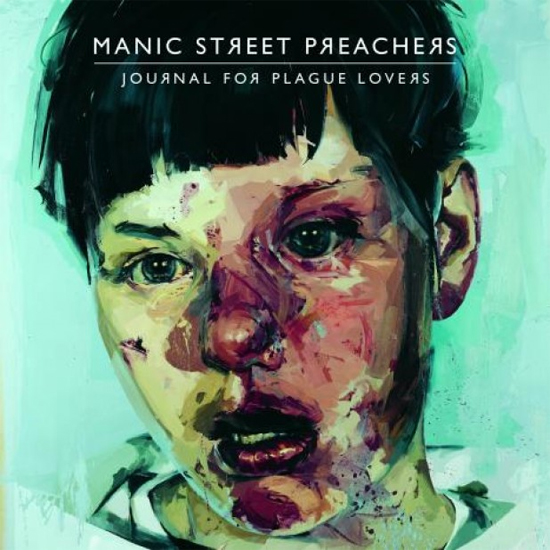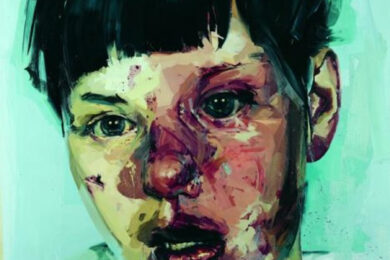Peeled Apples
Talk about hitting the ground running… If you’d read nothing of the background to the Manic Street Preachers’ ninth album and instead expected a linear progression from 2007’s comparatively camp and bombastic Send Away The Tigers; then this opening burst of acerbic, pumping rock-muscle will totally blind-side you. Recorded in Wales’ Rockfield Studios during the latter part of 2008, ¬Journal for Plague Lovers merges the last available musings of Richey Edwards and a mature band with the perspective and desire to process them.
We’re told there are to be no singles, but if there were this would probably be it (the bridge even distantly echoes ‘Temptation’ by Heaven 17). It’s incredibly immediate too; tight but with acres of wide-open space, courtesy of producer Steve Albini’s fondness for leaving a band the fuck alone and just documenting the results on analogue tape. References to The Holy Bible are there for sure ; the ominous, distorted bass intro reminiscent of Archives of Pain, hi-hats that sounds like they’re floating miles above the rest of the drum-kit too, but crucially that feeling of choking desperation is missing.
Jackie Collins Existential Question Time
This is interesting; a poppy and somewhat jaunty guitar track founded on late 70s post-punk like The Skids, with the kind of surreal lyricism that must have been a nightmare to actually cram into a song; "if a married man fucks a catholic, and his wife dies without knowing" for example, but they do it in style and James is right back to his best form, mixing his tuneful persona when begging the question we all wanted to ask "Oh mummy, what’s a Sex Pistol?" with the full-on roar that wouldn’t have been out of place on some of the more animated moments on Gold Against The Soul. Like most of the tracks, short and sharp.
Me And Stephen Hawking
A stop/go intro, interspersed with nothing but fresh Welsh air, then a thunderous tribal almost, drum tattoo with Sean Moore battering seven shades of shit out of his kit; this must be the only song ever to effectively marry together the iconic theoretical physicist and the rather sad wrestler Giant Haystacks. Despite Bradfield’s delivery, these lyrics are a lot more light-hearted than you’d expect – the line "…me and Stephen Hawking / we laugh / we missed the sex revolution / when we failed the physical" being a case in point.
This Joke Sport Severed
Total change of pace now, with a clean and rather folk-tinged guitar intro. Where ‘Small Black Flowers That Grow In The Sky’, for example, was as cold as dead meat, this has huge and welcome warmth and a middle section that even has a Beatles-referencing Day in the Life breakdown. The song then resurfaces again with a tribal drum pattern and a really uplifting string backdrop, recalling A Design For Life. All of this is at distinct odds with talk of "bones being torn from skin".
Journal For Plague Lovers
The noise of shuffled paper, presumably the mouldy inner-sleeves of assorted 70s rock albums, harkens the feedback scarred start of this, a brilliant nod back to none other than Rush, another feisty three-piece who punched similarly above their weight. It specifically references their anthemic calling- card ‘Spirit Of Radio’. The guitar solo is suitably dated too, with a rather wonky off-kilter 70s feel to it and it works a treat. It’s not a place they’ve been previously and a really interesting shift in style and era. Allegedly the band wanted to try and make a song that 1980s saccharine-sweet AOR types Journey might have penned but then play it like Magazine.
She Bathed Herself In A Bath Of Acid
Ok, so now we have the first and most obvious link to producer Steve Albini’s past, because this would sit very comfortably on Nirvana’s In Utero; itself a close cousin to The Holy Bible and not just by virtue of the fact that neither Cobain nor Edwards were in good mental shape when each album was conceived. This possesses that unmistakably distorted drum sound common to a lot of Albini produced material, along with the same triumphantly tormented bellow of nihilism which characterised Nirvana on the burn-out, amid somewhat familiar discussions of actual physical distortion. While arguably one of the record’s key reference points to other comparable material, it is still unmistakably their own.
Facing Page: Top Left
Again we get more space and a bit of folk, but this time it’s mingled with what sounds like a harp. Refreshingly, though, where previous low-key efforts, again ‘Small Black Flowers . . .’ is a good example, have been inclined to emit warning signals of frigidity, this thankfully has a reassuringly warm and upbeat air, while ruminating about "tinted UV protection" and the associated risk of skin cancer.
Marlon J.D.
Synthy drums sounding muffled by wads of cotton wool perhaps, for a second threatening to evoke thoughts of later-era Ultravox are quickly sent packing by this particularly assertive and distinctly punky delivery from Bradfield, while the guitars circle menacingly in the back-ground. Vocally, this album is highlighting JDB’s vastly underrated ability adapt into the structure of any song and this is a great example and an album highlight.
Doors Closing Slowly
Very, very dark and claustrophobic. A funereal death march summoning doom and despair. It’s that advancing, repetitive drumming and the ominous and strangled wail of feedback that really unsettles and the ticking clock at the end adds to the overall sense of imminent descent into someplace bad. For some reason it has the kind of controlled scary feel that let’s say the Velvet Underground and even Radiohead have touched on over the years.
All is Vanity
THAT drum sound again but this would be as close as you’d possibly get on here to filler. After an initially promising post-punk start punctuated with staccato drum fills from Moore, it reveals itself to be akin to something like say Faster but far less machined and robotically urgent. Not by any means the best thing on here.
Pretension/Repulsion
More quick-fire, machine-gunned drums from Moore and an initial sound that conjures thoughts of REM circa Murmur. The chorus sadly lets it down a bit and despite cries of "BORN.A.GRAPHIC vs PORN.A.GRAPHIC" doesn’t actually salvage this from being pretty standard fare.
Virginia State Epileptic Colony
More post punk jangle reminiscent of REM with a twist of Wire. The vocals are rather unusual actually and a little awkward too. In truth this isn’t too far removed from some of the relatively lo-fi stuff that appeared on 2001’s Know Your Enemy.
William’s Last Words/Baglady
A noise which sounds like large and very effervescent tablets being dropped into water introduce a clearly very nervous (and tone deaf) Nicky Wire, who proceeds to indulge himself in a pretty painful , wistful ballad along the lines of something Lou Reed might have undertaken, very , very late at night. It’s hard to make a case for it being any good, but what is much better however is the four or so blissful minutes of silence which separate it from hidden track number 13, entitled Baglady. Worth the wait it is too, as it could have been lifted directly off The Holy Bible without anyone noticing. This ensures that Journal For Plague Lovers makes up the required numbers (THB had 13 tracks too), while being the track that echoes its predecessor most loudly.



